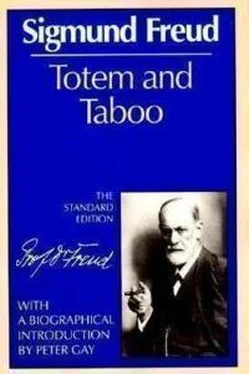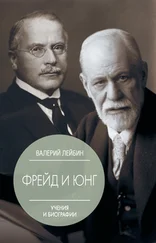Зигмунд Фрейд - Totem and Taboo
Здесь есть возможность читать онлайн «Зигмунд Фрейд - Totem and Taboo» весь текст электронной книги совершенно бесплатно (целиком полную версию без сокращений). В некоторых случаях можно слушать аудио, скачать через торрент в формате fb2 и присутствует краткое содержание. Год выпуска: 2014, Издательство: epubBooks Classics, Жанр: Психология, на английском языке. Описание произведения, (предисловие) а так же отзывы посетителей доступны на портале библиотеки ЛибКат.
- Название:Totem and Taboo
- Автор:
- Издательство:epubBooks Classics
- Жанр:
- Год:2014
- ISBN:нет данных
- Рейтинг книги:3 / 5. Голосов: 1
-
Избранное:Добавить в избранное
- Отзывы:
-
Ваша оценка:
- 60
- 1
- 2
- 3
- 4
- 5
Totem and Taboo: краткое содержание, описание и аннотация
Предлагаем к чтению аннотацию, описание, краткое содержание или предисловие (зависит от того, что написал сам автор книги «Totem and Taboo»). Если вы не нашли необходимую информацию о книге — напишите в комментариях, мы постараемся отыскать её.
Totem and Taboo — читать онлайн бесплатно полную книгу (весь текст) целиком
Ниже представлен текст книги, разбитый по страницам. Система сохранения места последней прочитанной страницы, позволяет с удобством читать онлайн бесплатно книгу «Totem and Taboo», без необходимости каждый раз заново искать на чём Вы остановились. Поставьте закладку, и сможете в любой момент перейти на страницу, на которой закончили чтение.
Интервал:
Закладка:
There is one warning to which we shall have to give heed in making this attempt. The similarity between taboo and compulsion disease may be purely superficial, holding good only for the manifestations of both without extending into their deeper characteristics. Nature loves to use identical forms in the most widely different biological connections, as, for instance, for coral stems and plants and even for certain crystals or for the formation of certain chemical precipitates. It would certainly be both premature and unprofitable to base conclusions relating to inner relationships upon the correspondence of merely mechanical conditions. We shall bear this warning in mind without, however, giving up our intended comparison on account of the possibility of such confusions.
The first and most striking correspondence between the compulsion prohibitions of neurotics and taboo lies in the fact that the origin of these prohibitions is just as unmotivated and enigmatic. They have appeared at some time or other and must now be retained on account of an unconquerable anxiety. An external threat of punishment is superfluous, because an inner certainty (a conscience) exists that violation will be followed by unbearable disaster. The very most that compulsion patients can tell us is the vague premonition that some person of their environment will suffer harm if they should violate the prohibition. Of what the harm is to consist is not known, and this inadequate information is more likely to be obtained during the later discussions of the expiatory and defensive actions than when the prohibitions themselves are being discussed.
As in the case of taboo the nucleus of the neurotic prohibition is the act of touching, whence we derive the name ‘touching phobia’ or délire de toucher . The prohibition extends not only to direct contact with the body but also to the figurative use of the phrase as ‘to come into contact’ or ‘be in touch with some one or something’. Anything that leads the thoughts to what is prohibited and thus calls forth mental contact is just as much prohibited as immediate bodily contact; this same extension is also found in taboo.
Some prohibitions are easily understood from their purpose but others strike us as incomprehensible, foolish and senseless. We designate such commands as ‘ceremonials’ and we find that taboo customs show the same variations.
Obsessive prohibitions possess an extraordinary capacity for displacement; they make use of almost any form of connection to extend from one object to another and then in turn make this new object ‘impossible’, as one of my patients aptly puts it. This impossibility finally lays an embargo upon the whole world. The compulsion neurotics act as if the ‘impossible’ persons and things were the carriers of a dangerous contagion which is ready to displace itself through contact to all neighbouring things. We have already emphasized the same characteristics of contagion and transference in the description of taboo prohibitions. We also know that any one who has violated a taboo by touching something which is taboo becomes taboo himself, and no one may come into contact with him.
I shall put side by side two examples of transference or, to use a better term, displacement, one from the life of the Maori, and the other from my observation of a woman suffering from a compulsion neurosis:
“For a similar reason a Maori chief would not blow on a fire with his mouth; for his sacred breath would communicate its sanctity to the fire, which would pass it on to the meat in the pot, which would pass it on to the man who ate the meat which was in the pot, which stood on the fire, which was breathed on by the chief; so that the eater, infected by the chiefs breath conveyed through these intermediaries, would surely die” [40] Frazer, The Golden Bough , II: Taboo and the Perils of the Soul , 1911, p. 136.
.
My patient demanded that a utensil which her husband had purchased and brought home should be removed lest it make the place where she lives impossible. For she has heard that this object was bought in a store which is situated, let us say, in Stag Street. But as the word ‘stag’ is the name of a friend now in a distant city, whom she has known in her youth under her maiden name and whom she now finds ‘impossible’, that is taboo, the object bought in Vienna is just as taboo as this friend with whom she does not want to come into contact.
Compulsion prohibitions, like taboo prohibitions, entail the most extraordinary renunciations and restrictions of life, but a part of these can be removed by carrying out certain acts which now also must be done because they have acquired a compulsive character (obsessive acts); there is no doubt that these acts are in the nature of penances, expiations, defence reactions, and purifications. The most common of these obsessive acts is washing with water (washing obsession). A part of the taboo prohibitions can also be replaced in this way, that is to say, their violation can be made good through such a ‘ceremonial’, and here too lustration through water is the preferred way.
Let us now summarize the points in which the correspondence between taboo customs and the symptoms of compulsion neurosis are most clearly manifested: 1. In the lack of motivation of the commandments, 2. in their enforcement through an inner need, 3. in their capacity of displacement and in the danger of contagion from what is prohibited, 4. and in the causation of ceremonial actions and commandments which emanate from the forbidden.
However, psychoanalysis has made us familiar with the clinical history as well as the psychic mechanism of compulsion neurosis. Thus the history of a typical case of touching phobia reads as follows: In the very beginning, during the early period of childhood, the person manifested a strong pleasure in touching himself, the object of which was much more specialized than one would be inclined to suspect. Presently the carrying out of this very pleasurable act of touching was opposed by a prohibition from without [41] Both the pleasure and the prohibition referred to touching one’s own genitals.
. The prohibition was accepted because it was supported by strong inner forces [42] The relation to beloved persons who impose the prohibition.
; it proved to be stronger than the impulse which wanted to manifest itself through this act of touching. But due to the primitive psychic constitution of the child this prohibition did not succeed in abolishing the impulse. Its only success lay in repressing the impulse (the pleasure of touching) and banishing it into the unconscious. Both the prohibition and the impulse remained; the impulse because it had only been repressed and not abolished, the prohibition, because if it had ceased the impulse would have broken through into consciousness and would have been carried out. An unsolved situation, a psychic fixation, had thus been created and now everything else emanated from the continued conflict between prohibition and impulse.
The main characteristic of the psychic constellation which has thus gone under fixation lies in what one might call the ambivalent behaviour [43] To use an excellent term coined by Bleuler.
of the individual to the object, or rather to an action regarding it. The individual constantly wants to carry out this action (the act of touching), he sees in it the highest pleasure, but he may not carry it out, and he even abominates it. The opposition between these two streams cannot be easily adjusted because—there is no other way to express it—they are so localized in the psychic life that they cannot meet. The prohibition becomes fully conscious, while the surviving pleasure of touching remains unconscious, the person knowing nothing about it. If this psychological factor did not exist the ambivalence could neither maintain itself so long nor lead to such subsequent manifestations.
Интервал:
Закладка:
Похожие книги на «Totem and Taboo»
Представляем Вашему вниманию похожие книги на «Totem and Taboo» списком для выбора. Мы отобрали схожую по названию и смыслу литературу в надежде предоставить читателям больше вариантов отыскать новые, интересные, ещё непрочитанные произведения.
Обсуждение, отзывы о книге «Totem and Taboo» и просто собственные мнения читателей. Оставьте ваши комментарии, напишите, что Вы думаете о произведении, его смысле или главных героях. Укажите что конкретно понравилось, а что нет, и почему Вы так считаете.






